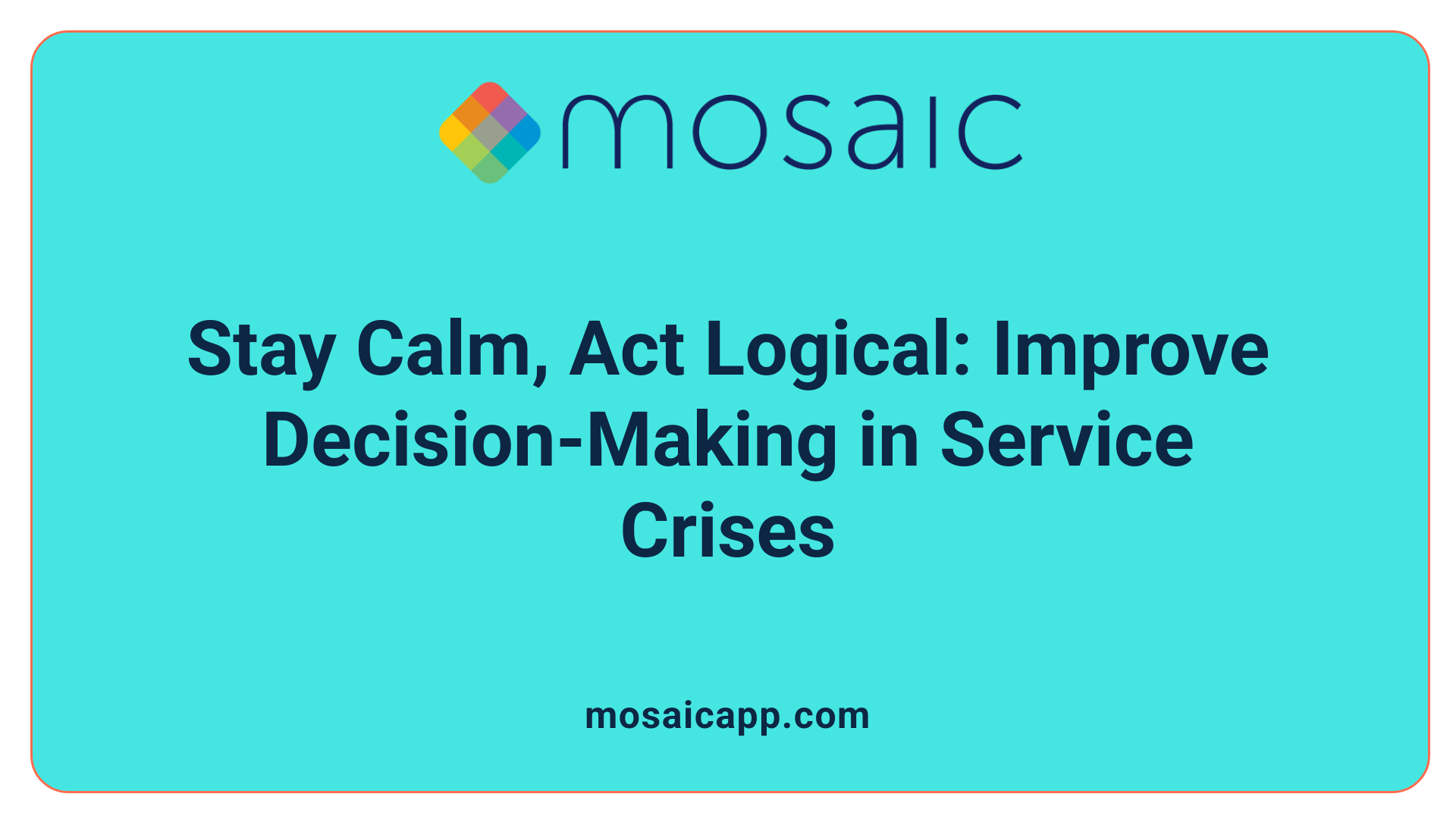Transforming Project Chaos into Coordinated Excellence
In the fast-paced world of project and resource management, service delivery often falls into a reactive firefighting mode — responding urgently to crises rather than proceeding with smooth, strategic flow. Drawing lessons from firefighting and integrating proven management principles, organizations can pivot from crisis-driven practices towards stable, efficient service execution. This narrative explores how strategic adjustments, clear communication, and a culture aligned with teamwork and planning can revolutionize service delivery.
Key Facts on Crisis Management and Resource Strategies in Service Delivery
- Firefighting practices highlight structured communication and clear roles to effectively manage crises.
- Maintaining calm and logical decision-making is essential for efficient crisis resolution in service delivery.
- Firefighters undergo extensive training (around 600 hours), which service teams should emulate through continuous simulation-based training.
- A well-defined chain of command and standardized communication protocols are fundamental to firefighting and beneficial for service teams.
- Flexibility and adaptability in planning prevent wasted resources and are critical in unpredictable crisis scenarios.
- Pre-briefings and role clarity before tasks enhance team performance and reduce errors under pressure.
- Ineffective resource management promotes a reactive firefighting cycle, disrupting steady service flow.
- Encouraging cross-functional collaboration helps prevent silos, enabling more efficient workflows.
- The culture of ‘hero syndrome’ and individual heroics leads to burnout and reactive behavior, harming long-term productivity.
- Shifting reward focus to team performance and implementing continuous resource monitoring fosters a sustainable, steady service delivery.
1. Crisis Management in Service Delivery: Learning from Firefighting

How can firefighting practices improve crisis management in service delivery?
Firefighting offers valuable lessons for service delivery, especially in how teams manage crisis situations effectively. The profession emphasizes strict communication protocols, a clear chain of command, and adherence to standard operating procedures. These principles ensure that everyone understands their role and responsibilities, which minimizes confusion during emergencies.
Service delivery teams can adopt this 'projectized' structure, viewing each client incident or task as a self-contained project requiring precise coordination and rapid responses. Clear communication and predefined roles become essential, especially when facing unexpected challenges or crises. This clarity prevents the chaos that often arises when teams are unsure of their tasks or decision-making authority.
Calm and logical crisis management in service delivery
Maintaining composure is crucial during any crisis. Firefighters are trained to remain calm, assess situations carefully, and make decisions grounded in logic rather than panic. This mindset is equally important in service delivery, where thoughtful problem-solving can determine whether a crisis escalates or is quickly resolved.
By fostering a calm and methodical approach, service teams can evaluate which aspects of a project or service are salvageable and prioritize actions accordingly. This strategic focus reduces wasted effort and promotes efficient crisis resolution.
Applying firefighting training principles to service delivery
Firefighters undergo rigorous formal training, averaging around 600 hours, that combines classroom learning with practical simulations. This 'train as you work' philosophy prepares them for high-pressure situations in the field.
Similarly, service delivery organizations should emphasize continuous training and simulations that mirror real-world crises. Such preparation builds confidence and sharpens team responsiveness when actual challenges arise.
Importance of communication protocols and chain of command
A well-defined chain of command is a hallmark of firefighting operations. It ensures that orders flow smoothly from leaders to team members without ambiguity. Communication protocols standardize how information is shared, reducing misunderstandings.
In service delivery, adopting similar frameworks fosters trust and clarity. Pre-briefings before major tasks or crisis situations help align the team’s understanding, while clear escalation paths ensure swift decision-making.
Flexible planning and adaptability in projectized service delivery
One of the critical lessons from firefighting is flexible planning. Firefighters know when a plan isn’t working and can adapt quickly, which prevents wasted resources and time.
Service delivery teams benefit greatly by embracing this adaptive mindset. Instead of rigidly sticking to initial plans, they can adjust deadlines, negotiate scope changes, or reallocate resources to meet evolving demands. This agility is essential during crises, where conditions often shift unpredictably.
Pre-briefings and role clarity for enhanced team performance
Before a firefighting mission, teams hold pre-briefings to clarify objectives, assign roles, and review procedures. This preparation builds a strong team attitude and reduces errors.
Service delivery teams should incorporate similar onboarding and briefing processes. When team members fully understand their responsibilities and the project goals, performance and collaboration improve, particularly under pressure.
In summary, techniques borrowed from firefighting — including structured communication, comprehensive training, calm crisis response, and flexible project management — equip service delivery teams to handle crises more effectively. These approaches foster resilience and promote high performance amid challenges.
2. Cultivating Sustainable Flow in Service Delivery Through Resource Management and Culture Shift

What organizational strategies help transition service delivery from reactive firefighting to steady flow?
Poor resource management has a significant impact on service delivery, often pushing organizations into a cycle of firefighting. When resources are not allocated efficiently, projects frequently exceed budgets and miss deadlines. This reactive approach forces teams into constant crisis mode, disrupting steady service flow and draining organizational energy.
One crucial strategy to combat this is fostering cross-functional collaboration. By encouraging departments to work together and share resources, organizations can prevent coordination failures that often trigger firefighting situations. This approach breaks down silos, enabling smoother workflows and more efficient handling of tasks.
Risks of ‘hero syndrome’ and reactive cultures in service delivery
A common pitfall in many organizations is the presence of ‘hero syndrome’ or a Savior complex. Here, employees engage in heroic crisis responses to gain recognition, positioning themselves as indispensable during emergencies. While this may appear beneficial in the short term, it fosters an unrealistic culture of constant firefighting, leading to burnout, imbalance, and decreased overall team performance.
Cultures that reward individual heroism rather than collaborative effort exacerbate this problem. They encourage reactive behavior instead of promoting strategic stability. Over time, this damages both morale and long-term productivity.
Advantages of team-focused rewards and strategic resource planning
Shifting the reward system to focus on team performance has significant benefits. When organizations emphasize collective achievements, they foster a sense of cohesion, shared responsibility, and sustainable success. This cultural change encourages proactive work and mutual support rather than isolated, crisis-driven heroics.
Strategic resource planning further reinforces this shift. According to PMI's research, only 26% of organizations consistently practice resource management for project execution, but those that do see marked improvements. By monitoring resource allocation actively and adjusting plans based on data, organizations can keep workloads balanced and projects on track.
Building checks and balances to prevent overextension and maintain steady delivery
Implementing checks and balances is vital for maintaining sustainable service delivery. Continuous monitoring of resource use helps prevent overextension of teams, which is a major contributor to reactive firefighting. It also enables timely adjustments to schedules and scopes, ensuring projects remain realistic and manageable.
These monitoring processes create an environment where steady flow is prioritized over last-minute crisis fixes. Over time, this approach solidifies a culture of stability and high performance.
Organizations that adopt these strategies—prioritizing cross-functional collaboration, combating hero syndrome, rewarding teams, and rigorously managing resources—can successfully transition from chaotic firefighting to steady and sustainable service delivery. This not only improves project outcomes but also enhances team well-being and organizational resilience.
From Reactive Firefighting to Proactive Flow
Embracing the lessons drawn from firefighting and sound resource management can transform service delivery from a cycle of frantic crisis responses to a state of strategic flow. By fostering clear communication, flexible planning, and team-based culture, organizations move beyond the constraints of reactive firefighting, leading to more predictable, efficient, and sustainable delivery of services. The journey from chaos to coordination is not just desirable but essential for maintaining competitiveness and long-term project success.

